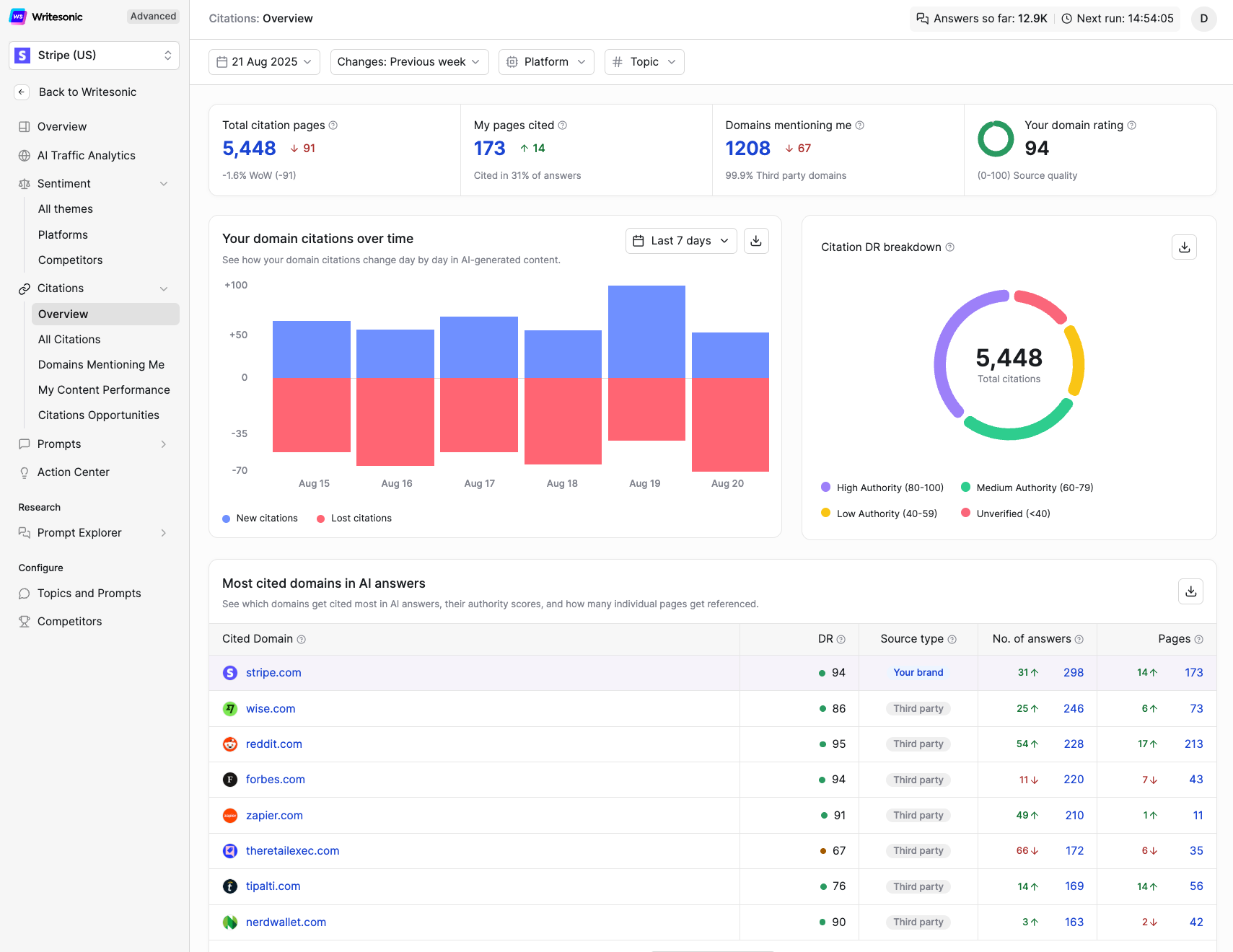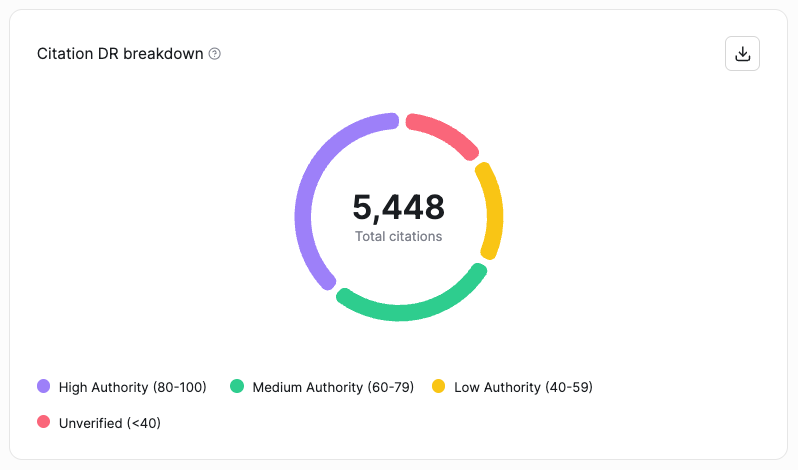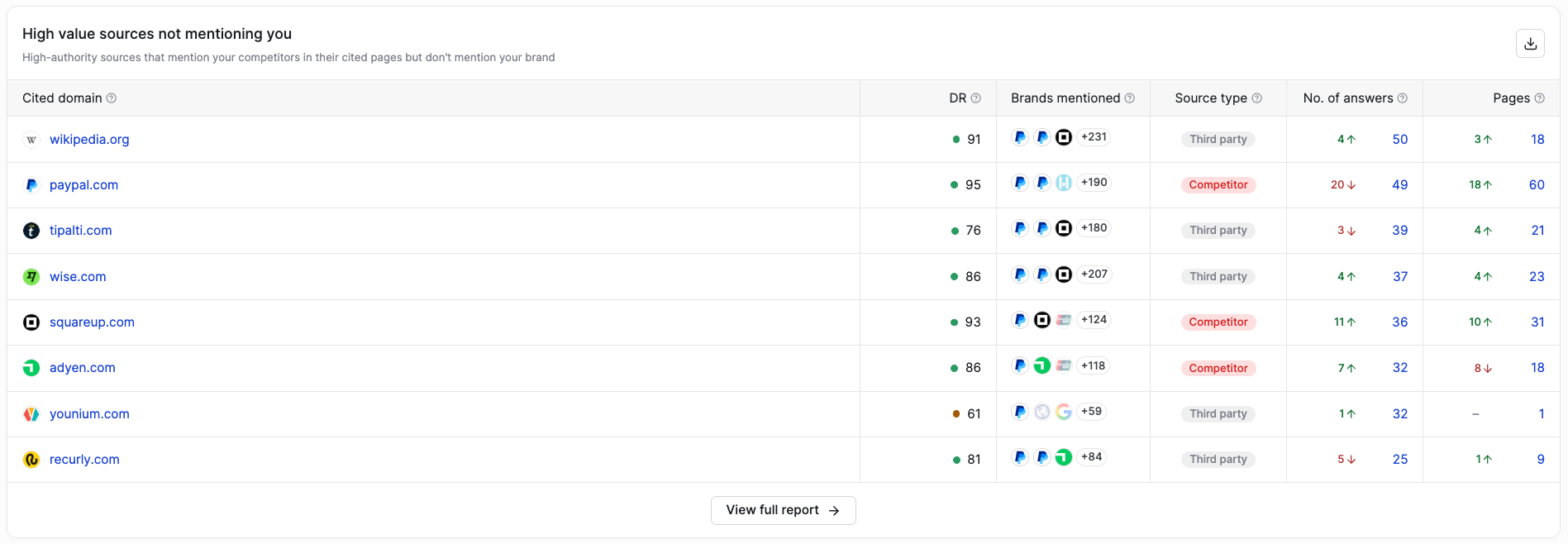Citations Overview
Citations Overview (GEO)
The Citations Overview page shows where AI answers link back to your content and who else shapes the conversation. Each widget highlights a different angle—volume, authority, growth, and gaps—so you can act quickly without digging through raw logs.

Quick Look Metrics
Four key performance indicators provide an instant snapshot of your citation performance:

Total Citation Pages
What this shows:
The total number of unique pages across the web that have cited your domain in AI-generated answers. A higher count indicates broader reach and authority recognition across AI systems.
Why it matters:
This metric measures your overall digital footprint in AI-powered search results and helps track growth in brand mentions over time. It's a direct indicator of how effectively your content strategy resonates with AI algorithms.
My Pages Cited
What this shows:
The specific number of pages from your domain that have been referenced as sources in AI answers, showing what portion of your content is being utilized by AI systems as authoritative sources.
Why it matters:
Understanding which content pieces are considered most valuable by AI engines helps optimize your content strategy and enables you to focus on creating more high-citation-potential content.
Domains Mentioning Me
What this shows:
The count of unique third-party domains that reference your brand or link to your content in their AI-visible pages. Higher numbers indicate stronger brand presence and industry recognition.
Why it matters:
This measures brand awareness across the digital ecosystem, identifies potential partnership opportunities, and tracks the effectiveness of your PR and link-building efforts.
Your Domain Rating
What this shows:
A quality score (0-100) that measures your domain's overall authority and trustworthiness. Higher scores indicate stronger domain authority and credibility.
Why it matters:
Domain rating directly impacts citation likelihood - higher authority domains are more frequently cited by AI systems. This score provides a benchmark for improvement efforts and helps prioritize SEO initiatives.
Your Domain Citations Over Time
What this shows:
A time-series graph displaying citation trends over your selected period. Blue bars represent new citations gained while red bars show citations lost, with the net change visible in the overall bar height.

Why it matters:
- Tracks momentum and growth trajectory of your citation profile
- Identifies periods of strong performance or concerning drops
- Helps correlate citation changes with content publishing or marketing campaigns
- Enables quick detection of issues affecting citation performance
Citation DR Breakdown
What this shows:
A circular chart categorizing your citations by the Domain Rating of citing sources:
- High Authority (80-100): Premium, highly trusted sources
- Medium Authority (60-79): Established, credible sources
- Low Authority (40-59): Developing or niche sources
- Unverified (<40): New or low-trust sources

Why it matters:
Citations from high-authority domains carry significantly more weight in establishing your credibility. This breakdown helps you assess citation quality, identify opportunities to improve your profile, and validate content credibility when cited by authoritative sources.
Most Cited Domains in AI Answers
What this shows:
A ranked table of domains most frequently cited in AI responses, displaying domain authority scores, source types (Your brand/Third party/Competitor), number of AI answers citing each domain, and total page citations.

Why it matters:
This competitive benchmarking reveals where you stand versus competitors and industry leaders. It identifies content gaps where competitors are winning citations and helps set realistic goals based on industry standards.
High Value Sources Not Mentioning You
What this shows:
High-authority domains that cite your competitors but haven't yet cited your brand. Each source displays its DR score, which brands it mentions, and citation frequency. "Competitor" tags identify domains heavily citing your competition.

Why it matters:
These represent immediate opportunities for outreach and content development. This list provides specific targets for PR efforts and helps understand where competitors have advantages you can potentially capture.
Your Top Performing Pages
What this shows:
A ranked list of your website pages receiving the most citations in AI answers, including page titles/URLs, number of citing AI answers, and brand mention status.

Why it matters:
These are your content champions driving citation success. Understanding what makes these pages successful helps replicate winning patterns across other content and guides future content creation strategies.
Competitive Citation Analysis by Topic
What this shows:
A comparative matrix showing citation performance across different topic categories. Rows represent topics while columns display citation counts for each brand, with higher numbers indicating topic dominance.

Why it matters:
- Reveals strategic positioning - your strengths and weaknesses by topic
- Identifies content territories to defend or attack
- Uncovers market gaps where no brand dominates
- Enables focused resource allocation to high-opportunity topics
FAQs
Q: How often is citation data updated?
A: Citation data is updated daily, with historical data available for trend analysis over various time periods.
Q: Why might my citations decrease over time?
A: Citations can decrease due to content updates, algorithm changes, increased competition, or when cited pages are removed or modified. Regular content updates and quality improvements help maintain citation levels.
Q: How can I improve my citation rate?
A: Focus on creating authoritative, comprehensive content relevant to your industry, improve domain authority through quality backlinks, and ensure content is well-structured for AI crawlers.
Q: What's the difference between "citations" and "backlinks"?
A: Citations are mentions of content as sources in AI-generated answers, while backlinks are traditional hyperlinks from other websites. Citations indicate AI-recognized authority, while backlinks contribute to SEO.
Q: Can I export citation data for reporting?
A: Yes, most sections include export options to download data for further analysis or reporting purposes.
Q: How do I know which competitors to track?
A: Start with direct business competitors, then expand to include content competitors who rank for similar topics in AI answers, even if they're not direct business rivals.
Updated 4 months ago
